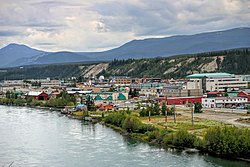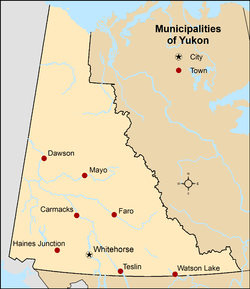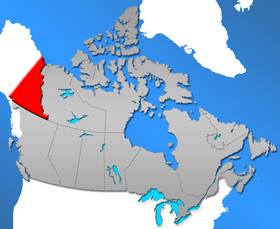User:Hwy43/List of communities in Yukon/sandbox


Yukon is the second-most populous of Canada's three territories with 33,897 residents as of 2011 and is the smallest territory in land area at approximately 475,000 km2 (183,000 sq mi).[1] Yukon's eight municipalities cover only 0.2% of the territory's land mass[a] but are home to 80.2% of its population.[1][2][3]
Municipal governments are created by the Government of Yukon in accordance with the Municipal Act of 2001.[4] Classifications of municipalities under the Municipal Act include cities and towns.[4]
Whitehorse is the capital of Yukon and its only city. The remaining seven municipalities are towns of which four were villages that were continued as towns upon adoption of the 2001 Municipal Act.[4] The Municipal Act stipulates governance of these municipalities.[4]
Over two-thirds of the population of Yukon (68.7%) resides in Whitehorse, the largest municipality in the territory at 23,276 residents.[2] It is also the largest municipality by land area at 416.54 km2 (160.83 sq mi).[2] The smallest municipality by population is Teslin with 122 residents, while the smallest by land area is Mayo at 1.06 km2 (0.41 sq mi).[2]
Municipalities
[edit]- Cities
A proposal to incorporate a community as a city can be initiated under the Municipal Act at the request of the Minister of Community Services, a municipal council, or a minimum 30% of residents that are eligible electors if the community has an estimated population over 2,500.[4] The only city in Yukon is Whitehorse, which is the largest among the three cities in Northern Canada's three territories. It had a population of 23,276 residents and a land area of 416.54 km2 (160.83 sq mi) in the 2011 Census.[2] The City of Dawson is a former city in Yukon that now has town status but is permitted to retain "city" in its official name.[4]
- Towns
A proposal to incorporate a community as a town can be initiated under the Municipal Act at the request of the Minister of Community Services, a municipal council, or a minimum 30% of residents that are eligible electors if the community has an estimated population over 300.[4] All municipalities that were villages prior to the adoption of the 2001 Municipal Act were continued as towns but were permitted to retain "village" in their official names.[4] Yukon has seven towns. Dawson City is the territory's largest town by population with 1,319 residents and Faro is the largest by land area 203.57 km2 (78.60 sq mi).[2] Teslin is the smallest town by population at 122 residents while Mayo is the smallest by land area at 1.06 km2 (0.41 sq mi).[2]
| Name | Status[3] | Official name | Incorporation date[5] | Population (2011)[2] |
Population (2006)[2] |
Change (%)[2] |
Land area (km²)[2] |
Population density (per km²)[2] |
|---|---|---|---|---|---|---|---|---|
| Carmacks | Town | Village of Carmacks | November 1, 1984 | 503 | 425 | 18.4 | 36.95 | 13.6 |
| Dawson | Town | City of Dawson | January 9, 1902 | 1,319 | 1,327 | −0.6 | 32.45 | 40.7 |
| Faro | Town | Town of Faro | June 13, 1969 | 344 | 341 | 0.9 | 203.57 | 1.7 |
| Haines Junction | Town | Village of Haines Junction | October 1, 1984 | 593 | 589 | 0.7 | 34.49 | 17.2 |
| Mayo | Town | Village of Mayo | June 1, 1984 | 226 | 248 | −8.9 | 1.06 | 213.2 |
| Teslin | Town | Village of Teslin | August 1, 1984 | 122 | 141 | −13.5 | 1.92 | 63.6 |
| Watson Lake | Town | Town of Watson Lake | April 1, 1984 | 802 | 846 | −5.2 | 6.11 | 131.3 |
| Whitehorse | City | City of Whitehorse | June 1, 1950 | 23,276 | 20,461 | 13.8 | 416.54 | 55.9 |
| Total | — | — | — | 27,185 | 24,378 | 11.5 | 733.08 | 37.1 |
Unincorporated communities
[edit]Hamlets
[edit]Settlements
[edit]- Beaver Creek
- Burwash Landing
- Carcross
- Conrad
- Destruction Bay
- Johnson's Crossing
- Keno City
- Old Crow
- Pelly Crossing
- Ross River
- Stewart Crossing
- Swift River
- Tagish
- Upper Liard
First Nations communities
[edit]Indian reserves
[edit]Indian settlements
[edit]Ghost towns and First Nations communities
[edit]- Aishihik
- Conrad
- Clinton Creek
- Dalton Post
- Elsa
- Fort Frances
- Fort Selkirk
- Forty Mile
- LaPierre House
- Little Salmon
- Rampart House
- Miner's Prayer
- Minto
- Paris
- Silver City
- Snag
- Stewart River
Other
[edit]Small Yukon places
[edit]The following is a list and short description of places in the Yukon that may often be found on various maps, but whose population is too small to warrant their having their own article.
Dalton Post
[edit]Dalton Post or Shäwshe is a former trading post and First Nations community on the Tatshenshini River. It was on the Dalton Trail near the Haines Highway. Today, it is a prime Pacific salmon fishing spot and serves as a base for whitewater rafting expeditions on the Tatshenshini and Alsek Rivers in the Tatshenshini-Alsek Park.
Herschel
[edit]Herschel was a settlement on Herschel Island, serving as a whaling station, North-West Mounted Police post and Hudson's Bay Company store. It has been long abandoned, and shoreline erosion is threatening to wipe out the remaining buildings.
Jake's Corner
[edit]Jake's Corner is a spot on the road, at historical mile 866 of the Alaska Highway, at the junction with connections to the Tagish Road and the Atlin Road. There are a small number of area residents, the junction being best known for a gas station and café. The gas station has numerous examples of old machinery.
Klukshu
[edit]Klukshu's more recent history is as a seasonal aboriginal fishing community, benefitting from a large Chinook salmon run. Located near the Haines Highway, it has no permanent population. Interpretive information is provided by the Champagne and Aishihik First Nations.
Little Salmon
[edit]Little Salmon is located on the Robert Campbell Highway between Faro and Carmacks, and stretches along the lake of the same name and the Yukon River. The only non-residential establishment is the Yukon government highway maintenance camp at Drury Creek. It was formerly an important settlement of the Little Salmon/Carmacks First Nation.
Miner's Prayer
[edit]Miner's Prayer was settled near the Blackstone River Mining Concern, providing a retreat where the miners could indulge in billiards, alcohol and other entertainment otherwise forbidden on the mining settlement. Today it is home to fewer than thirty permanent residents. It can be accessed by gravel road veering West from mile 57 on the Dempster Highway.
Silver City
[edit]Silver City, a historic mining town, is today only the residence of a small number of people, one household being a bed and breakfast establishment. It is located at historical mile 1053 of the Alaska Highway.
Stewart River
[edit]Stewart River is a former settlement at the juncture of the Yukon and Stewart rivers. A few buildings and cabins remain, as well as private museum, which are threatened by erosion. It was founded as a trading post in the 1880s before the Klondike Gold Rush to serve placer miners working along the Stewart River. The Burian family was still living there in the late 1980s.
Sulphur
[edit]Sulphur or Sulphur Creek was a mining camp south-east of Dawson on a creek of the same name that flows into the Indian River. A post office was opened there on 1903-10-28 by G. W. Coffin. It was closed in July 1922. The place is mentioned in Jack London's story, To Build a Fire.
See also
[edit]- List of designated places in Yukon
- List of population centres in Yukon
- List of cities in Canada
- List of towns in Canada
Notes
[edit]- ^ Of the remaining 99.8%, Unorganized Yukon accounts for 98.1% of the territory's land mass.[2]
References
[edit]- ^ a b "Population and dwelling counts, for Canada, provinces and territories, 2011 and 2006 censuses". Statistics Canada. January 13, 2014. Retrieved June 23, 2014.
- ^ a b c d e f g h i j k l m "Population and dwelling counts, for Canada, provinces and territories, and census subdivisions (municipalities), 2011 and 2006 censuses (Yukon)". Statistics Canada. January 13, 2014. Retrieved January 15, 2014.
- ^ a b "Yukon Communities". Government of Yukon. April 4, 2014. Retrieved June 24, 2014. Cite error: The named reference "munis" was defined multiple times with different content (see the help page).
- ^ a b c d e f g h "Municipal Act" (PDF) (PDF). Government of Yukon. 2002. Retrieved January 6, 2014.
- ^ "Association of Yukon Communities Incorporation Dates". Association of Yukon Communities. Retrieved June 14, 2014.
- Robert G. Woodall, The Postal History of Yukon Territory Canada, Lawrence, MA, Quarterman, Revised edition, ©1976, ISBN 0-88000-086-4
External links
[edit]- Yukon-Municipal Information
- Association of Yukon Communities
- Yukon Municipal Government Websites
- Yukon community profiles web site
- Yukon Government: Department of Community Services



